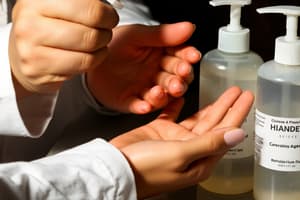Podcast
Questions and Answers
What does a rating of '+++' indicate regarding microbial contamination levels?
What does a rating of '+++' indicate regarding microbial contamination levels?
- Little contamination
- No contamination
- Moderate contamination
- A lot of contamination (correct)
When evaluating the effectiveness of a hand-cleansing agent, which aspect should be examined for diversity?
When evaluating the effectiveness of a hand-cleansing agent, which aspect should be examined for diversity?
- The temperature of the water used
- Physical characteristics like color and texture (correct)
- The timing of the hand-washing process
- The absolute number of microbes only
What might affect the observed effectiveness of various hand-cleansing agents besides the agent itself?
What might affect the observed effectiveness of various hand-cleansing agents besides the agent itself?
- The type of table used during the experiment
- Variations in technique among students (correct)
- The cleanliness of the lab section
- The size of the student's hands
Which of the following interpretations indicates that the cleansing agent was very effective?
Which of the following interpretations indicates that the cleansing agent was very effective?
What aspect of microbial persistence should students consider after washing their hands?
What aspect of microbial persistence should students consider after washing their hands?
What is the purpose of allowing agar plates to cool in an upright position?
What is the purpose of allowing agar plates to cool in an upright position?
At what temperature and duration are media typically sterilized in an autoclave?
At what temperature and duration are media typically sterilized in an autoclave?
What happens to brain-heart infusion agar (BHIA) when removed from the autoclave?
What happens to brain-heart infusion agar (BHIA) when removed from the autoclave?
How should agar plates be prepared to avoid airborne contamination?
How should agar plates be prepared to avoid airborne contamination?
What is the correct procedure to check for growth in tubes and plates?
What is the correct procedure to check for growth in tubes and plates?
What should you avoid doing when transferring organisms with a loop?
What should you avoid doing when transferring organisms with a loop?
Why is the technique called 'fishtail streak'?
Why is the technique called 'fishtail streak'?
What adjustment should be made when transferring a BSL-2 organism?
What adjustment should be made when transferring a BSL-2 organism?
What is the correct order of steps after picking up a sterile agar slant?
What is the correct order of steps after picking up a sterile agar slant?
When handling culture tubes, what should you do after touching the loop to the growth on the agar?
When handling culture tubes, what should you do after touching the loop to the growth on the agar?
What is the primary goal when using a loop for transferring cultures?
What is the primary goal when using a loop for transferring cultures?
What is the recommended procedure for flaming the culture tube?
What is the recommended procedure for flaming the culture tube?
Which action should be taken immediately after making the fishtail streak?
Which action should be taken immediately after making the fishtail streak?
What is crucial to remember when withdrawing the culture tube from the wire?
What is crucial to remember when withdrawing the culture tube from the wire?
What should be done with the culture tube after touching the loop to the growth?
What should be done with the culture tube after touching the loop to the growth?
Flashcards are hidden until you start studying
Study Notes
Hand-Cleansing Agents
- Relative growth contamination scale: +++ (a lot), ++ (moderate), + (little), 0 (none).
- Emphasize consistency in evaluation despite subjective interpretations of contamination levels.
- Observe diversity in microbial growth by noting colors, shapes, textures, and the number of different organisms.
Questions on Effectiveness
- Identify which hand-washing agent effectively removed microbes from fingertips.
- Determine the least effective agent for microbial removal.
- Consider variables influencing differences between individuals’ finger cleanliness.
- Recognize any persistent microbes post-washing and explore possible factors causing retention.
Media Preparation and Handling
- Weigh ingredients accurately before suspending them in distilled or deionized water.
- Heating may be necessary to ensure complete dissolution of media ingredients.
- Media sterilization: autoclave at 121 °C for 15 minutes.
Types of Media
- Tubed media types: broth, agar slant, agar deep tube.
- Agar slants are allowed to solidify at an angle; agar deeps solidify upright.
- Agar plates are prepared by pouring sterilized medium into sterile Petri dishes.
Microbial Culture Handling
- Proper handling of culture tubes includes flaming and maintaining sterility during transfers.
- Utilize a loop to inoculate agar surfaces carefully without damaging the media.
- Maintain a sterile environment to avoid contamination during transfers.
Labeling Protocols
- Always label sterile media with name, date, medium type, and inoculum source.
- Consistent adherence to labeling ensures accurate tracking of cultures and experiments.
Miscellaneous Techniques
- Employ "fishtail" streaking technique for loop inoculation on agar, resembling the motion of a fish tail.
- Keep hands steady and flaming techniques consistent for ensuring proper sterilization between transfers.
Studying That Suits You
Use AI to generate personalized quizzes and flashcards to suit your learning preferences.




